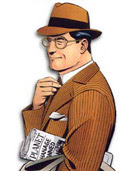 We all know how a newspaper is supposed to look. But today, newspapers are forgetting their proud traditions and letting electronic computers ruin the way they look, not to mention upsetting well-established newsroom and pressroom traditions.
We all know how a newspaper is supposed to look. But today, newspapers are forgetting their proud traditions and letting electronic computers ruin the way they look, not to mention upsetting well-established newsroom and pressroom traditions.Doing page makeup in a type case is an art, and it's one our readers appreciate. Every time they pick up their newspapers, they subliminally hear the "clunka--clunka" sound of a Linotype machine, the "thlick thlack thilck DING" of a reporter's typewriter, and the combination of hums and clanks a two-story-high web press makes as it rolls a continuous stream of paper over the printing mats.
There's also the "whiirrr-THUD" of a pneumatic tube full of typewritten sheets being delivered to the proofreaders for a final check before that copy goes to the typesetters in the next room.
But now, more and more newspapers are yielding to the phantom benefits of technology. News departments look and feel more like computer rooms or TV production offices than like proper newsrooms. Where there was once a low wooden railing with a swinging gates separating the newsroom from the foyer, now the first thing visitors to the newspaper see is a security guard, and they must get past this gatekeeper before they can meet with the computerized, college-bred, buttoned-down "journalists" who have replaced yesterday's street-smart reporters and editors.
Linotype machines and the proud, apron-wearing men who run them are being replaced by computer operators who speak in gibberish. Editors and art directors approve page makeups on light tables or giant computer screens, with nary an ink smudge or bit of oil on their fingers from handling fresh galleys.
And the newspaper itself? It is becoming a cold, unyielding mass of computer-aligned color pictures and words written by journalists who all write in a measured, unemotional style that will never lead to the creation of great writing the way Hemingway's newspaper experience led to The Sun Also Rises, Charles Finney's work as reporter and proofreader led to The Circus of Dr. Lao, and Max Miller's work as a waterfront reporter led to I Cover the Waterfront.
The worst thing of all, though, is that with this cold-type computer junk replacing real hot-metal typography, and soulless self-registering offset presses replacing real printing machines, almost anyone will soon be able to have a newspaper printed for next to nothing. You just watch. Before you know it, every large city is going to have a dozen underground and neighborhood weeklies that will siphon off ad revenue and reader loyalty from the dailies.
I know. Technology is the coming thing, and we can't fight it. And today's journalists are far better-educated than old newspapermen like Bret Harte, Mike Royko, and H.L. Mencken, none of whom could get a job with a major newspaper today.
But I still miss the crowded pages, intricate masthead engraving, and dark wire photos that have defined a newspaper's identity for a dozen generations of Americans. I miss the quirky ramblings of self-trained writers like H. L.Mencken. I miss the rhythm of the printing press and
the tobacco-and-sweat smell of a reporter who is typing the final words of a 2,000 word expose three minutes before deadline while a frantic editor, eyes bleary from 14 straight hours of cheap rye whiskey and thick newsroom coffee, leans over his shoulder.
Instead of trying to write in a computerized world, I should have been a pair of ragged claws, scuttling across the floors of silent seas.
I have heard the modems singing, each to each.
I do not think that they will sing to me.
-- Author unknown
Sphere: Related Content





No comments:
Post a Comment